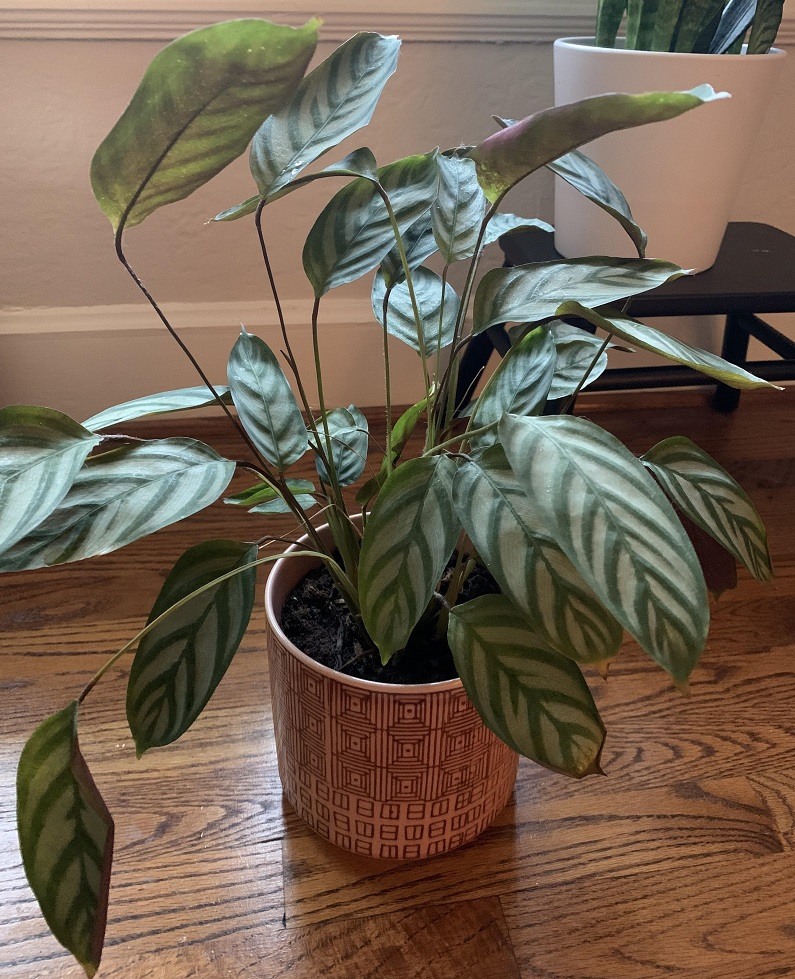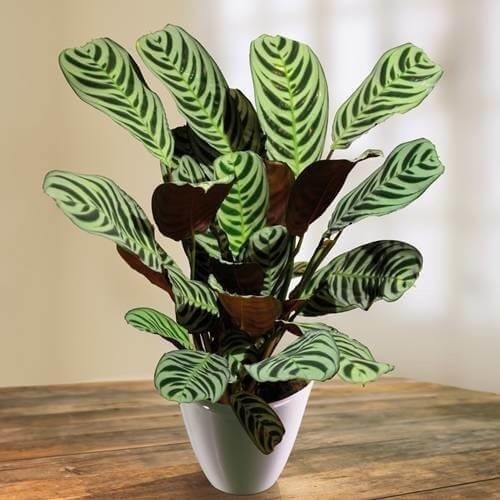Never Never plant (ctenanthe) is a tropical plant with variegated foliages that add liveliness to any interior décor. Growing this evergreen plant at home can be a daunting experience due to sudden weather-climate changes.
Never Never plant care involves the provision of bright indirect sunlight, well-draining soil, high humidity, and relatively moist potting soil that never gets soggy. Maintain a temperature range of 55-85oF and feed the plant every month during the growing season.
The ctenathe plant brings tropical vibes at home and creates a lasting impression. Every houseplant enthusiast needs to provide a hospitable environment and growing conditions for this evergreen plant to thrive well.
Continue reading this comprehensive ctenanthe plant care guide to learn all the information to allow this tropical evergreen plant to thrive with minimal challenges. You’ll also discover common problems and their respective solutions.
You May Also Enjoy: How to Care for China Doll Plant

What Does Never Never Plant Looks Like?
Ctenathe plant has spear-shaped foliages with dark green background and silver stripes. The silver bands are the reason behind the Never Never plant name.
The Never Never plant belongs to the Marantaceae family due to the production of flowers. It hails from the rainforest of Brazil, Costa Rica, and other parts of Central America.
The multi-colored foliages are the reason behind being grown as an ornamental plant. The tropical plant is more vulnerable to frost since it suffers from irreparable damages.
The indoor Never Never plant can reach seven feet tall with oval foliages of up to sixteen inches. But the container size determines the exact size of the ctenanthe plant at home.
A dark maroon color will appear undersides of the leaves at some point to result in more vibrant colors and textures. Little pruning is essential to foster compact growth habits.
The ctenathe plant is non-toxic to pets and children. The best option is to keep the houseplant away from children and pets to avoid destruction.
Never Never Plant Care Details
| Origin | Brazil, Costa Rica, and Central America |
| Scientific Name | Ctenanthe oppenheimiana |
| Common Names | Never Never Plant Brazilian Snow Plant |
| Maximum Growth (Approx.) | 7ft tall |
| Light Requirements | Bright indirect sunlight. Avoid direct sunlight due to the scorching effect. |
| Watering Frequency | Maintain moist soil without getting soggy. Too much water will cause root rot. |
| Soil Requirements | Nutrients rich and well-draining potting soil. Mix potting soil with peat moss and perlite in equal proportions. |
| Temperature Range | 55-85oF (13-29oC) |
| Fertilizer Application | Feed the plant every month during spring and summer. Use balanced and water-soluble fertilizer. |
| Humidity Requirements | Medium to high humidity. Low humidity causes leaf curling and browning tips. |
| Flowering | Small and white or yellow insignificant flowers. |
| Pruning and Maintenance | Minimal pruning routine to enhance compact size and remove dead leaves. |
| Propagation | By seeds and stem cuttings. |
| Re-potting | 1-2 years during springtime |
| Ctenanthe Varieties | C. burle-marxii, C. oppenheimiana, C. marantifolia. |
| Toxicity | Non-toxic to pets and humans. |
Sources: North Carolina State Extension
How to Care for a Ctenanthe Plant
Never Never Plant Soil Requirements
Ctenathe plants do best in well-draining potting soil. The potting mix structures enhance roots aeration and prevent waterlogging.
I recommend the use of potting soil with the addition of peat moss and perlite. The peat moss helps the potting mix to hold moisture, and perlite enhances proper drainage.
Add compost to the potting soil to increase fertility. Research shows that fertile soil enhances vegetative growth and healthy foliage development.
Another excellent option is to buy potting soil suitable for tropical plants (Check the Best Deals on Amazon). The commercial soil tends to meet all the tropical plant requirements.
Light Requirements for Ctenanthe Plants
Never Never Plants thrive in an environment with bright indirect sunlight. The sunlight intensity tends to mimic its rainforest ecosystem.
Too much direct sunlight might cause leaves scorching or plant drooping. Besides that, too little sunlight causes leaf discoloration and stunted growth.
Place your ctenanthe plant near the window that receives natural light. The shears or curtains will help to reduce the sunlight intensity. It helps to maintain the foliages’ vibrant colors.
Bright indirect sunlight helps to maintain the plant’s vibrant colors and fosters proper physiological activities. Consider east or north-facing windows as the best spot for ctenanthe.
Water Requirements for Never Never Plants
Ctenanthe plants receiving the correct amount of water tend to thrive. Never Never plants are tolerant to different soil moisture without becoming fussy.
Inspect the soil moisture first before watering. The rule of thumb is to ensure the potting soil is not dry and soggy to foster healthy growth.
Consistent soil moisture ensures the plant stays hydrated and develops bright hues on leaves. I recommend inserting the index finger in the soil to determine the moisture level.
Water ctenanthe plants twice a week during spring and summer. Remember to reduce the watering frequency in winter due to the dormancy stage.
Overwatering might lead to root rot, while under watering causes wilting. These two conditions tend to ruin the plant’s appearance and leaves.
Use a container (Best Deals on Amazon) with drainage holes at the bottom to get rid of excess water. Besides that, schedule a strict watering routine for your favorite houseplant.
Temperature Requirements for Ctenanthe Plants
Never Never plant is native to the Amazon rainforest and can still survive under indoor temperatures without becoming fussy. The best temperature range is 55-85oF (13-29oC)
The ctenanthe plant is sensitive to frost since it causes irreparable damages. Any temperature below 55oF and above 85oF will ruin your favorite houseplant.
Be sure to keep the ctenanthe plants away from hot and cold drafts. Use a digital thermometer (Best Deals on Amazon) to monitor indoor temperature changes.
Fertilizer Application for Ctenanthe Plants
Never Never plant is a light-feeder tropical plant when compared to other houseplants. But fertilizer nutrients facilitate vegetative growth and attractive foliages development.
Use dilute fertilizer-rich nitrogen and phosphorous to feed your ctenanthe plant. Fertilize your ctenathe plants every month during spring and summer.
Too much fertilizer will cause root and leaf burn. Flush the potting soil with distilled water in case of over-fertilization. Another excellent option is to transplant it into a fresh potting mix.
I recommend the use of compost over artificial fertilizer to avoid over-fertilizer issues. It would be best to read my article on how to make homemade fertilizer for houseplants.
Never Never Plants Humidity Requirements
The ctenanthe plants love a warm and humid environment to thrive. Every houseplant enthusiast should provide a moist and stable environment for these tropical plants to stay happy.
Too low indoor humidity can cause the browning of leaf tips and edges. Juvenile leaves will develop yellow halos and curls. Never Never plants do best in the humidity range of 40% and above.
Mist the ctenanthe leaves from time to time to increase the indoor humidity. Provide better ventilation to inhibit pests from attacking your houseplant.
Another option is to use a humidifier (Check Best Deals on Amazon) to increase the local air moisture around your favorite houseplants.
Pruning and Maintenance
Ctenathe plants need regular pruning to maintain a compact size. Besides that, the routine helps to remove old and dead leaves from the plant for better appearance purposes.
Use a sharp pruner (Check Best Deals on Amazon) to remove the dead or old leaves. Be sure to sterilize the pruner before using it.
Never Never Plant Propagation
Ctenanthe plant propagation is a no-brainer task since it is through division. Cut a stem to about 4-5 inches long with three leaves.
I recommend undertaking the never never plant propagation during springtime. The season allows the houseplant to develop roots faster and grow better.
How to Repot Never Never Plants
Ctenanthe plants are less vulnerable to root-bound issues. I recommend re-potting the houseplant after every two years or more.
Use a slightly bigger pot to accommodate the plant. Remember to transplant an overgrown ctenathe plant during springtime.
You May Also Enjoy: How to Care for Lipstick Plant
Common Problems and Solutions
Pests
Ctenanthe plants are less susceptible to pests. But it does not imply that these tropical plants from the Amazon rainforest are resistant to all pests.
Mealybugs, thrips, and spider mites are the leading pests on never never plants. Take the time to investigate plant foliages and identify the exact insect attacking your plant.
Use insecticidal soap to treat the bugs on your houseplant. Be sure to isolate your ctenanthe plant from other indoor plants.
Diseases
Too much moisture and poor ventilation can result in grey molds. Provide optimum humidity and well-draining soil to avoid this fungal disease.
Root rot is another lethal condition to never never plants. It occurs due to overwatering and poor drainage potting mix. Consider re-potting the houseplant early before it dies.

Frequently Asked Questions
Is Ctenanthe Plant Toxic to Pets and Humans?
No. All ctenanthe species are non-toxic plants to pets and humans. But some pets and humans do experience minor allergic reactions on the skin.
I recommend keeping the never-never plants away from toddlers and pets. It helps to avoid plant destruction that ruins their growth or appearance.
Why Is Ctenanthe Called Never-Never Plant?
It is due to the spear-shaped leaves with dark-green background and sliver bands. The silver stripes or bands are the main reasons behind the name.
Why Are My Never-Never Plant Leaves Curling?
Ctenanthe leaves curling is a natural process among prayer-plants. If the plant leaves do not uncurl during the day, increase the indoor humidity level around it.
Why Is My Never-Never Plant Yellowing Leaves?
Yellow leaves are due to insufficient sunlight exposure. The best option is to move your plant to a spot that receives bright indirect sunlight. Too much direct sunlight might scorch the leaves.
Conclusion
Ctenanthe plants (never-never plants) can reach seven feet tall under proper growing conditions. It can spread horizontally and not exceed 12-18 inches in height.
Never-never plants have oval-shaped leaves with beautiful silver patterns. The exact plant size depends on the container size.
The most popular ctenanthe varieties are C. Burle-marxii, C. oppenheimiana, and C. marantifolia. These ctenanthe species have the same growing condition and care regime.
How to care for a ctenanthe plant involves the provision of bright indirect sunlight, high humidity, well-draining soil, a regular watering regime, and feeding every month in springtime.
